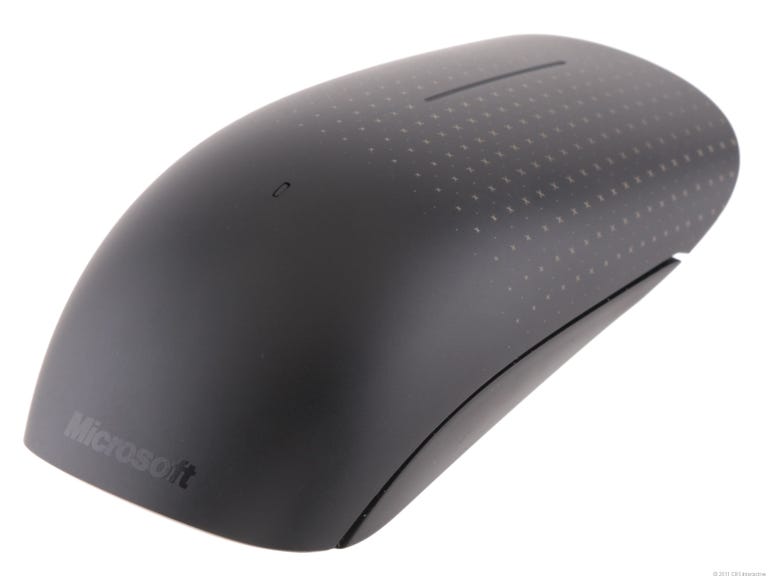 Why You Can Trust CNET
Why You Can Trust CNET Microsoft Touch Mouse (Black) review: Microsoft Touch Mouse (Black)
Microsoft Touch Mouse (Black)
Microsoft's Touch Mouse is the product of a research project Microsoft conducted a few years ago intended to reimagine the role of the lowly computer mouse in anticipation of the growing popularity of touch-based input. Designed to work exclusively with Windows 7, the $79 Touch Mouse is expensive, but it's also refreshingly intuitive, relying on a series of simple gestures that add to, rather than transform, Windows 7 navigation. While we've felt mostly ambivalence toward all-in-one desktops with touch support, the Microsoft Touch Mouse is a far more effective implementation of touch input, and we'd recommend it to anyone willing to spend the money.
The Good
The Bad
The Bottom Line
What we like most about the Touch Mouse is that you don't have to learn a complex vocabulary of gestures to take advantage of it. You don't even really need to use the touch input at all. Although almost the entire top surface of the mouse has underlying touch sensors, it still has a mechanical button that recognizes both left and right mouse clicks the way you would expect. And while the touch features will only work in Windows 7, the Touch Mouse will behave like a standard mechanical mouse if you use it with other operating systems.
Setting the cordless Touch Mouse up in Windows 7 is simple. The AA-battery-powered device comes with a Micro-USB receiver and uses a standard optical sensor for motion tracking. Windows 7 recognizes the Touch Mouse as soon as you plug in the receiver, but in order to use the touch features, you need to get the drivers from Microsoft's hardware-related downloads Web page. Simply download and launch the Touch Mouse driver executable and click through the appropriate installation cues.
After installation, you can launch a brief tutorial that walks you through the various touch gestures. The Touch Mouse supports one-, two-, and three-finger gestures, and the tutorial encourages you to try them yourself so that you get a feel for them.
Walking through the tutorial exposes you to the genius of the simple Touch Mouse input scheme. Essentially the number of fingers you use maps to the level at which you want to interact with your computer.
One-finger gestures are designed to help you navigate within an application. You can use your index finger to scroll up and down on a page, as you would with a scroll wheel. You can also swipe your index finger from side to side to pan across a document. With your thumb you can navigate forward and back through your browser history.
Two-finger gestures work at the next conceptual level up, and let you position the application window within the Windows 7 desktop environment. Swipe two fingers up or down to maximize or minimize an application window. If you swipe two fingers to either the left or the right you engage Windows 7's "snap" feature, which automatically positions a program window to occupy half of the screen.

With three fingers, you get macro-level commands. Swipe up to display a screen with preview windows of all currently open applications, from which you can simply click on one to select it. Swipe down to hide everything and return to your normal Windows desktop screen.
Those three gesture groups represent the full complexity of the Microsoft Touch Mouse. The only one we don't like is the thumb-side forward and back navigation. It's responsive enough--all of the gestures are, really--but you need to tuck your thumb in a way that feels awkward. We'd rather have hard forward and back buttons.
We can also report that the Touch Mouse works well in varied Windows 7 environments. We tried it with a single display, a dual monitor setup in extended desktop mode, and with an all-in-one with its own built-in touch support. The Touch Mouse worked without a problem in all cases.
The primary competitors to the Touch Mouse are the Apple Magic Mouse and Magic Trackpad, and the two implementations are very different. Apple's touch devices heartily embrace touch, the Magic Trackpad in particular with its pinch-to-zoom function and its entirely touch-based navigation. The touch input options of Microsoft's Touch Mouse are more limited, but they feel as if they complement the familiar mousing experience, rather than attempt to replace it entirely.
Conclusion
Whether one approach is better than the other is moot, not least because it involves larger questions about operating system preferences (we've never liked the Apple Magic Mouse in general). We expect that most Windows 7 users will find that the Microsoft Touch Mouse speeds navigation in an intuitive manner. Regarding the heavily touch-focused Windows 8, Microsoft would only confirm that we should expect that the Touch Mouse will be compatible. Though $80 seems like a lot to risk now on a device that might not be able to take full advantage of Microsoft's next operating system, the Touch Mouse is effective enough now that we can recommend it for general purposes to any Windows 7 user.


